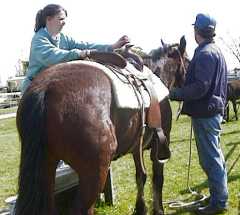|
Clicker training is a product of studies in behavioral science of operant
conditioning which was first described by B.F. Skinner. Dolphin trainers
were the first to capitalize on Skinner's work. After all, it is rather
difficult to try to train an animal who could simply swim away on a whim.
Before long the dolphins were demonstrating complex behaviors on command
which in turn piqued the interest of zoo and circus trainers as well as
the more progressive of the dog trainers.
Karen Pryor teamed up with canine behaviorist Gary Wilkes to produce
a series of seminars and Karen wrote a popular book, Don't Shoot the Dog
which is considered by many to be a landmark text on the subject of dog
training.
Extending the philosophy of clicker training to horses seemed like a natural
progression to some, however many of us die hard traditional natural horsemen
felt that behavior motivated for treats was an independent behavior (eating)
while pure natural horsemanship was a social behavior (interaction). Since
we desired interaction between the horse and rider, many of us were concerned
that a focus on treat rewards would tend to make the horse more independent
which could come at the expense of our social goals; we would produce horses
that could do complex tricks but did not develop the interactive skills which
we desired.
Perhaps in the empirical sense we were right. Heavy doses of clicker training
without appropriate application within the framework of a sensible natural
horse training program could result in horses which did not tune into the handler's
space, energy and intentions. Clicker training is not a replacement for appropriate
resistance free or low resistance (natural horsemanship) handling techniques.
However what we weren't prepared to experience was the incredible power that the
clicker methodology has in dealing with a wide variety of behavioral and cognitive
issues. Any horse handler can benefit from a safe, quick and humane means of
short circuiting undesirable behaviors and to turn on the horse's thinking apparatus.
In our experiments with a couple of heretofore difficult, unapproachable and untouchable
wild horses, we were able to interrupt the animals' stress-feedback loop and focus
them on objects and activities which in a matter of a few days allowed us to safely handle, halter, groom and
even trim feet of these horses which heretofore kept humans at bay.
One of these mares is owned by a person who is very experienced with wild horses.
She had this mare for a year, the mare was very defensive and the best she could do
was to try to handle her in a chute in an attempt to deal with her basic needs
until she would kick the chute down. Yet after a relatively short time with the
clicker, she would pick up her feet on command, rest them across my leg and let me
attempt some serious farriery work.
The second mare managed to get her halter off shortly after being adopted, wouldn't
let anyone but her adopter approach (and that was just to touch her shoulder) and
was extremely evasive in a round pen situation. Her feet were way too long to
work her much in the round and we needed some safe, quiet method to get our hands on
her. Within a few days after starting clicker training her adopter was putting
weight in the saddle while the mare quietly stood "ground tied."
To say the least we were quite impressed with the potential of clicker training and
have begun to use it in other situations, getting equally favorable results.
It is our intent by producing this web document to provide our perspective as to the
results which we have achieved, why we think these approaches worked and how we
integrated clicker fundamentals into our natural horsemanship program.
The end product:
Patience a short time later as a certified
handicapped riding program horse
Notice that with all this going on
she has a hind leg cocked
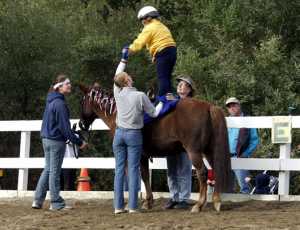
How did we do this?
|
OK, so I get a treat
after that noise
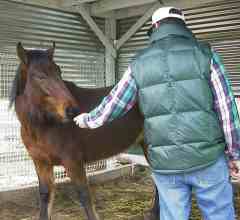
Thinking, not reacting
(Getting back to those scary places)
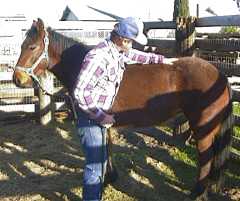
Not bad for a day's work.
(A much happier horse than
the day before.)
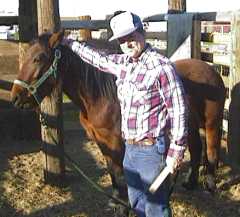
Just like a pro
(First time through the tires,
4th day being handled)
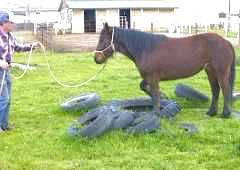
The idea here is to keep the horse
relaxed during the training process
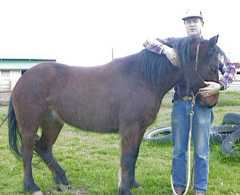
Trimming on a slack lead line
(Day 8)
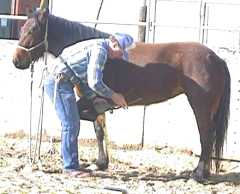
First time placing weight in the saddle.
(Patience is not tied)
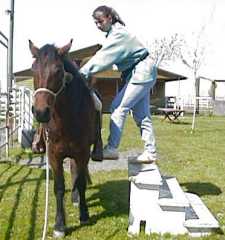
A responsible horse has a
better life. (Grazing in
the pasture with Nell)
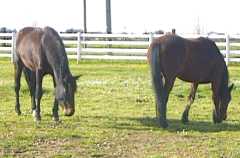
|

